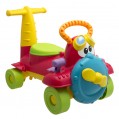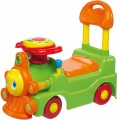Design
—
Car. Design, reminiscent of ordinary cars. Such wheelchairs have 4 wheels, their design can imitate full-size cars of real brands, racing cars, etc. However in most cases, a small driver still has to sit "on horseback", like on a motorcycle.
—
SUV. A specific type of design for a car (see above), which imitates not passenger cars, but all-wheel drive off-road vehicles. Some "SUVs" differ from "cars" very slightly, others may have pronounced signs of 4x4 technology — for example, large wheels, dummies of additional headlights, "kenguryatnikov", etc. In this design, there are also models created with an eye on real car brands.
—
ATV. In fact, the key difference between this design and the “SUVs” described above is the steering wheel (or its imitation), made in the form of characteristic motorcycle handles — like on real ATVs. The rest of the features are largely similar, because. ATVs are also considered off-road vehicles and may have distinctive external features.
—
Motorcycle. Rollers imitating classic two-wheeled motorcycles. Typically, such designs are equipped with wide wheels, which allows them not to tip over even when stationary (unlike real motorcycles). However, wheelchairs of this type are among the most unstable, they require more caution from the rider than, for example, "cars". Therefore, in m
...ost cases, "motorcycles" are designed for the older age group.
— Tricycle. Design for three-wheeled motorcycles, with one wheel in front and two in the back. Similar models are in many ways similar to the “motorcycles” described above, but are somewhat more stable, due to which they are well suited for younger children.
— Steam locomotive. Rollers of this type, in most cases, practically do not differ in layout from the cars described above. Their only distinguishing feature is the peculiar shape of the hull, imitating, in fact, a steam locomotive.
— Airplane. Like the "steam locomotives" described above, this type of wheelchair practically does not differ from "cars" in its main features. However, the steering wheel in such models is often made in the form of a steering wheel, a rotating propeller can be installed in the front part, and the body, of course, is designed accordingly — with “tail”, “wings”, etc.
— Special equipment. Wheelchairs designed for various types of special equipment — dump trucks, tractors, etc. The design features of such models may vary depending on what exactly is being simulated.
— In the form of an animal. The traditional and most famous version of such a wheelchair is a toy horse, but this is not limited to this, and the design can imitate another animal — for example, an elephant or a dog.Maximum baby's weight
The maximum weight of the driver that the wheelchair can withstand without breakdowns and other troubles. Usually this indicator is indicated not for a one-time “trip”, but for regular use over a long period of time. At the same time, many models are able to endure a short-term excess of the maximum weight without visible consequences, but it is still not recommended to do this — it is possible that the structure will not break immediately, but its service life can be noticeably reduced.
Also note that it is worth choosing a gurney according to the maximum weight with a certain margin, and not only because the child is constantly growing. The fact is that manufacturers can indicate the maximum weight for simple conditions — a flat surface without bumps; when hitting bumps, the load may exceed the calculated load, even if the weight of the rider is within the normal range.
Equipment
—
Back. Backrest in this case refers to any device that provides the rider with additional support from behind and reduces the likelihood of falling backwards. It can be either a separate part installed behind the seat, or a ledge on a solid structure. Anyway, this piece of equipment makes driving safer and more comfortable (although the specific degree of safety and convenience in different models may vary markedly).
—
Parental pen. A long handle mounted behind the back of the child so that an adult can comfortably hold on to it while standing next to it. Thus, the parent can to a certain extent control the movement of the child, stop him at the right time or vice versa, push, or even drive the baby.
—
Removable rocking stand. The presence in the design of the rocking chair (see "Type") of a removable rocking stand. The main advantage of this option is that by removing such a stand, you can reduce the weight and dimensions of the wheelchair: after all, the possibility of rocking is far from always required, which means that there is no need to carry all the equipment with you. In addition, a removable design may be more convenient than a non-removable design during transportation.
—
Footrest. A special stand on which the child can put his feet while sitting on a stretcher. This function is relevant primari
...ly for models equipped with a parent handle or rocking stand (see above). After all, during normal use of the wheelchair, the baby constantly pushes off the ground with his feet, and steps are not needed; but if the parent is carrying him, or if the structure is used as a rocking chair, there is no need to step on the ground once again (sometimes it is even fraught with injuries).
— Protective bumper. Handrail safety device around the seat: the child can hold on to the bumper with his hands, in addition, this function significantly reduces the risk of falling off the stroller. It is used mainly in models designed for the younger age group.
— Seat belts. The wheelchair has seat belts. This feature is found mainly in models equipped with footrests and a parent handle, where the child can ride like in a parent-controlled stroller. The seat belts not only reduce the risk of falling off the seat, but also protect against bruises, for example, during a sudden stop.
— Stops from turning over. Safety devices to prevent rollover. Usually we are talking about protection against falls forward or backward, because. the risk of falling to the side is low (because the child rests his feet on the ground most of the time), and such falls themselves are not as dangerous as tipping "over the handlebars" or on the back. The presence of stops from turning over is important, first of all, for models designed for the smallest children, in whom coordination is still relatively poorly developed.
— Boot. The presence in the design of a classic boot — that is, a device for transporting various items on a stretcher. Such devices can have a different design — a box in the back, a compartment under the seat, a body like a truck, etc. Their capacity, of course, is small, but for toys and other important items for the baby, it is usually quite enough; and in general, the role of boots is more entertaining than practical.
— Trailer. Presence in a delivery set of a wheelchair of the trailer. The trailer provides additional features in games, and in some models it also enhances the resemblance to full-size adult vehicles. In addition, it plays the role of an external boot, which, unlike the built-in one described above, can be removed.
— Game panel. The presence in the design of the game panel — a set of various moving elements, such as knobs, switches, figurines of fairy-tale characters, dummies of real devices, etc. Such a panel provides the baby with additional entertainment. Its presence is typical for models of the younger age group.
— Klaxon. The wheelchair has a special sound signal (klaxon). Initially, the horn is intended to warn others; however, given the speed and nature of the use of stretchers, in this case, this function rather provides an additional similarity to real machines — it is used much less often for its original purpose. The horn can be either pneumatic (a kind of "pipe" that makes a sound by blowing air) or electronic; it can make both a characteristic "beep" and other sounds, depending on the model.
— Light effects. The presence of lighting effects in the design of the wheelchair. It can be either multi-coloured light bulbs or built-in lights that imitate headlights (usually this is just an imitation, such “headlights” are not designed for the role of lighting sources). This feature not only provides a bright and original appearance, but also increases the visibility of the wheelchair — this is especially important at dusk and/or in places where traffic is possible (for example, in certain sections of the courtyards).
— Sound effects. This function implies the presence of a speaker through which the wheelchair can play various sounds. The set of these sounds may be different depending on the model: motor rumble, melodic trills, siren, etc. This gives the baby additional features in the games. Note that the horn (see above) does not apply to sound effects, it is indicated separately.Swivel wheels
The presence of
swivel wheels in the design of the wheelchair. Usually the front wheels are made swivel, they are controlled using the steering wheel, but there are other design options — for example, self-orienting wheels (as on an office chair or a trolley in a store); they allow you to move the wheelchair in any direction. Anyway, this function makes it easier to control the stretcher — without it, it would be difficult to move otherwise than forward or backward.

